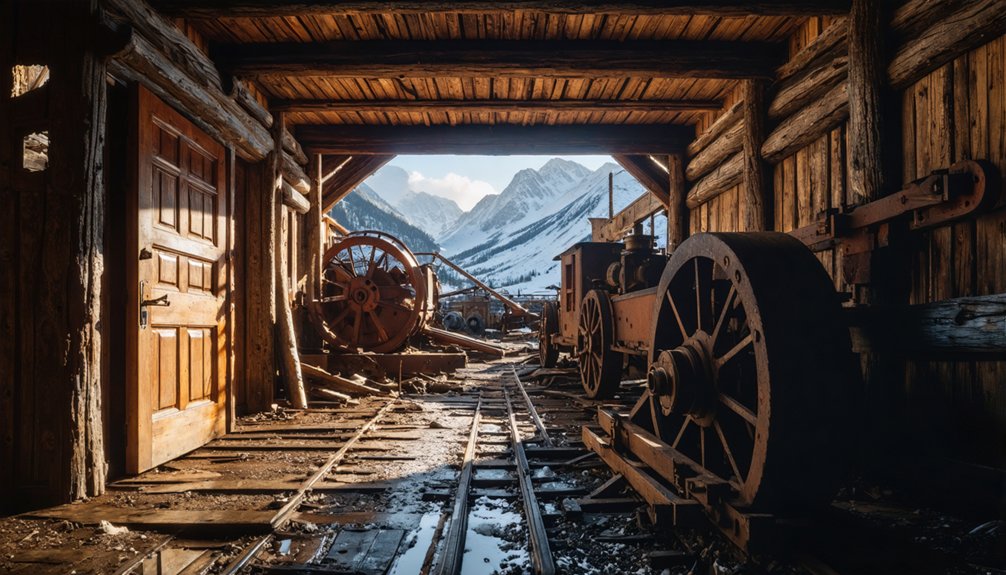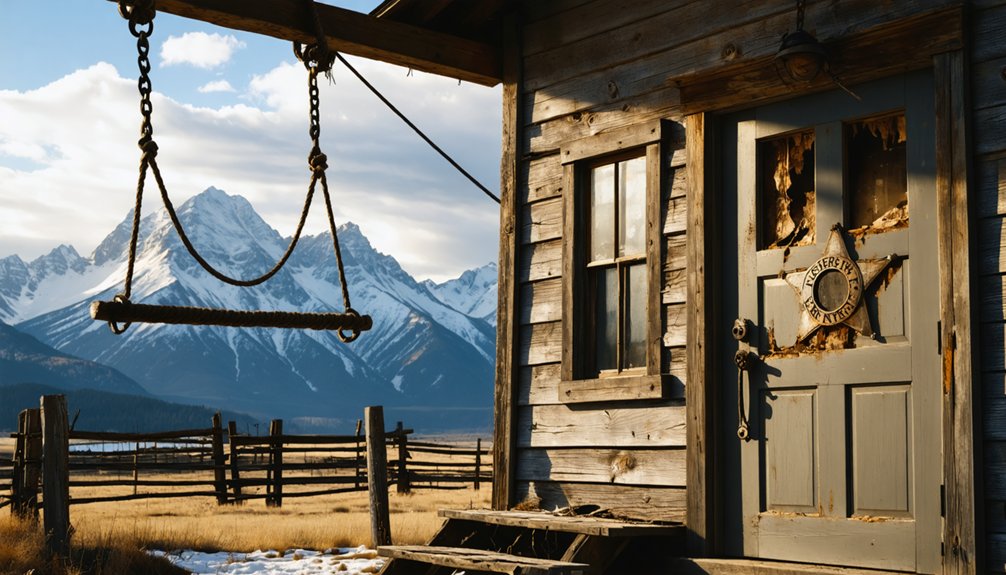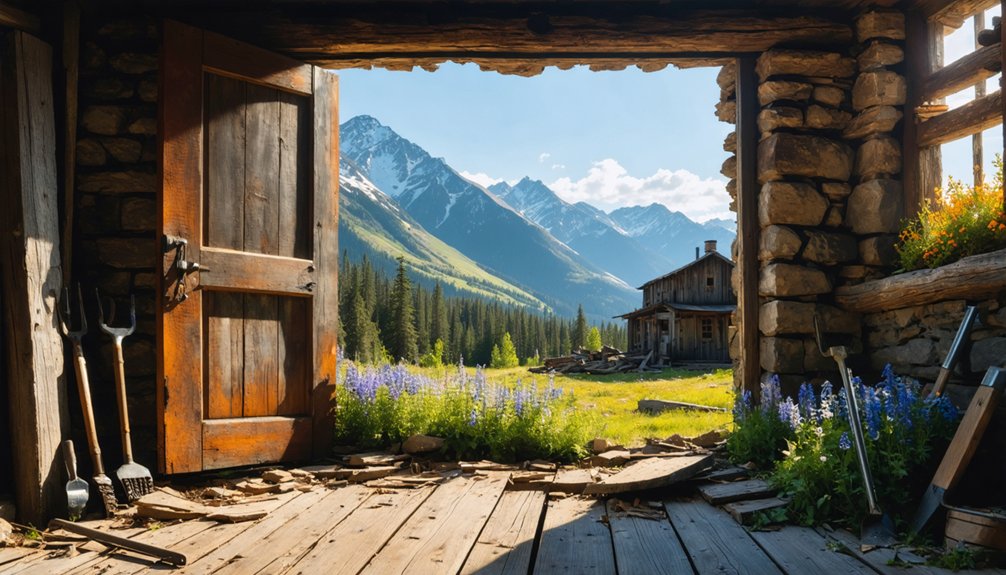Dakan, Colorado was a short-lived mining settlement established in 1896 on the slopes of Dakan Mountain in Douglas County. Named after founder William “Allan” Dakan, this frontier community quickly grew to 300 residents with essential businesses before disappointing ore quality led to its abandonment by 1898. You’ll find no standing structures today, but the site offers mountain vistas along Dakan Road near Sandstone Ranch. The terrain itself tells the story of western boom-and-bust dreams.
Key Takeaways
- Dakan was a short-lived Colorado mining settlement founded in 1896 and abandoned by 1898 when ore quality proved disappointing.
- Named after pioneer William “Allan” Dakan, the town quickly grew to 300 residents with businesses including a hotel, restaurant, and grocery.
- The post office operated for only 19 months (December 1896 to August 1898), marking the town’s brief economic activity.
- No standing structures remain today, with the site’s historical significance lying in the natural surroundings and terrain.
- Located on Dakan Mountain in Douglas County, the ghost town exemplifies the boom-and-bust pattern common in frontier mining ventures.
The Birth of a Mountain Mining Settlement (1896)
Hope drew hundreds to the rugged slopes of Dakan Mountain in 1896, when a prospector’s announcement of valuable ore sparked the birth of a new mining settlement.
You’d find Dakan nestled in the Front Range of western Douglas County at 39°14′15″N 105°03′59″W, where freedom seekers and fortune hunters converged.
Like many communities throughout Colorado, Dakan’s development was directly tied to the economic fluctuations of the mining industry, with its fate ultimately determined by the productivity of local claims.
When the silver price crash of 1893 affected neighboring communities, Dakan managed to survive by diversifying its mining operations beyond silver.
William “Allan” Dakan: The Town’s Civil War Veteran Founder
Before miners flocked to Dakan Mountain’s promising slopes, one man had already recognized the region’s potential and staked his claim. William “Allan” Dakan, born in Ohio in 1840, brought his Civil War veteran’s resilience to Colorado Territory in 1870.
At 30, he journeyed west to lower Gove Creek, leaving behind limited post-war opportunities in Missouri.
Allan’s resilience was immediately tested as he built a log cabin and established a homestead in territory still facing Indian threats. Later that year, his wife Lizzy braved the dangerous wagon trail west with their children.
Frontier life demanded extraordinary courage—from building cabins in hostile territory to families traversing perilous trails toward uncertain futures.
Together, they’d ultimately raise seven children amid frontier challenges most couldn’t imagine. The family sustained themselves through ranching and farming, producing various crops and dairy products. His story of determination reminds us of Jeanne Furr, who will soon celebrate 100 years of her own remarkable journey.
Though the settlement bearing his name wouldn’t be officially established until 1896, Allan had already laid the foundation for what would become a community shaped by his pioneering spirit.
Life in the Rocky Mountain Frontier
Living in Dakan meant facing the brutal realities of Rocky Mountain mining—you’d struggle against harsh winters, equipment failures, and the constant threat of mine collapses while extracting precious metals from unyielding stone.
You’d find frontier justice administered swiftly and often harshly, with mining disputes settled through informal community councils rather than formal courts, which remained distant luxuries.
Your family would endure profound isolation, with women and children particularly affected by the lack of schools, medical care, and social connections that characterized these remote mountain settlements. Each successive wave of settlers to Dakan faced similar challenges as those who established earlier frontier outposts throughout American westward expansion. Mining practices in Dakan followed the pattern of earlier frontiers, with settlers adapting European tools to meet the unique conditions of Rocky Mountain mineral extraction.
Mountain Mining Challenges
Mining in Colorado’s Rocky Mountains presented challenges that tested both human ingenuity and endurance at every turn. You’d face the harsh reality of low-grade ores requiring complex processing techniques that many small operations simply couldn’t afford. Mining companies often resorted to cyanide heap leaching methods similar to those that would later cause environmental disasters at sites like Zortman-Landusky.
The rugged terrain made transporting equipment and ore nearly impossible until railroads finally pushed through in the 1870s. Black Hawk’s smelters became crucial for processing the complex ores that smaller operations couldn’t handle.
Winter’s grip halted work for months, while labor disputes erupted as miners demanded better conditions amid dangerous work that claimed countless lives. At high altitudes, you’d struggle with hypoxia while working unstable slopes prone to collapse.
Water posed a dual challenge—sometimes scarce for processing, yet often contaminating nearby streams with heavy metals. These environmental impacts linger today, long after the mines went bankrupt and the boom towns emptied into ghosts like Dakan.
Daily Frontier Justice
Justice in Dakan operated on the razor’s edge between order and chaos, with few formal legal institutions to govern the remote mining community.
You’d find justice dispensed through miners’ courts where your neighbors served as both jury and executioners. These improvised tribunals lacked standardized procedures, often blurring the line between law and mob rule. Similar to the vigilantism that emerged in Idaho and Montana territories, these courts arose from the weak territorial enforcement in remote areas.
If you’d broken community standards, you might face public humiliation—tarred, feathered, or forced to stand on barrels while townsfolk jeered. These spectacles reinforced community solidarity while serving as deterrents. Trials were conducted with remarkable speed, typically commencing within hours of an alleged offense.
For more serious offenses, vigilante committees formed, conducting hasty trials followed by immediate hangings or banishments.
The system disproportionately targeted people of color, with Mexican Americans suffering the harshest consequences.
As territorial law slowly reached Dakan, these frontier justice practices gradually declined.
Family Isolation Hardships
While gold and silver brought hopefuls to Dakan’s mountainous terrain, they couldn’t prepare families for the crushing isolation that defined frontier life.
You’d face weeks without seeing another soul beyond your household, with mail delivery serving as your tenuous connection to civilization.
The isolation effects were profound. Your children would grow up with limited education and social interaction, while you’d battle constant anxiety about medical emergencies with the nearest doctor days away.
You’d become your family’s doctor, teacher, and entertainer out of necessity.
Yet this hardship forged remarkable emotional resilience. Families developed deep bonds through shared struggles, creating self-sufficient homesteads where you’d grow barley and oats, raise livestock, and craft everything needed for survival—because in Dakan’s remote wilderness, you’d no choice.
Mining Operations and Economic Pursuits

When William Wanner founded Dakan in 1896, he ushered in a brief but intense period of economic activity centered on precious metal extraction. Initial ore shipments valued at $35 per ton sparked optimism, drawing nearly 300 people to the settlement by Christmas that year.
The community quickly established essential businesses—a hotel, restaurant, saloon, and grocery—while mining technology remained relatively rudimentary compared to corporate operations elsewhere in Colorado.
Unfortunately, subsequent assays revealed the ore wasn’t as rich as first claimed. Community dynamics shifted as economic realities set in, with most miners abandoning their claims by 1898.
Dreams of wealth evaporated when ore quality failed to match initial reports, sending hopeful miners elsewhere.
Dakan’s trajectory mirrored many small Colorado mining camps—bright prospects followed by rapid decline when corporate capital and sustainable yields proved elusive.
The post office’s closure in August 1898 marked the end of viable economic activity.
The Brief Rise and Fall of Dakan’s Post Office (1896-1898)
Communication lifelines proved essential for isolated mining communities, and Dakan’s post office represented both the town’s legitimacy and its fleeting prosperity. Established on December 30, 1896, shortly after William Wanner’s promising ore shipment announcement, this significant hub for mining communications operated alongside the town’s hotel and saloon.
You can trace Dakan’s dramatic arc through its postal services—operating just 19 months before closing on August 2, 1898. The post office enabled important correspondence for the 300 residents who flocked to this Douglas County settlement, but as ore quality disappointed expectations, the town’s population vanished quickly.
The closure of this government outpost marked Dakan’s shift from hopeful mining venture to abandoned ghost town, a familiar pattern in Colorado’s boom-bust mining history.
Frontier Justice and Self-Reliance in Dakan

Far from the reach of formal law enforcement, Dakan’s residents embodied the quintessential frontier spirit of self-reliance and community-based justice that defined America’s western expansion.
You’d find families like the Dakans exemplifying this frontier resilience—Allan homesteading alone in 1870, while Lizzy traveled with two small children via wagon train to join him.
In the absence of courthouses and jails, disputes were settled neighbor-to-neighbor, with reputation serving as both currency and constraint.
When conflicts arose, don’t imagine formal hearings but rather direct confrontations or mediations by respected community members. This community solidarity wasn’t just preference but necessity.
With no authorities to call upon, settlers developed their own codes of conduct, carried firearms for protection, and relied on mutual aid networks that determined survival.
Lizzy’s solo journey became legendary precisely because it captured this essential frontier character.
What Remains: Exploring Dakan’s Ghost Town Site Today
Vestiges of Dakan’s once-vibrant community have largely disappeared into the Colorado landscape, leaving modern explorers with more questions than answers.
Like ghosts in the pines, Dakan’s frontier dreams fade into mountainous memory, whispering untold tales to those who listen.
When you venture to the coordinates 39°14′15″N 105°03′59″W in western Douglas County, you’ll find no standing structures marking this former mining settlement. The historical significance lies beneath your feet and in the natural surroundings that shaped frontier life.
- Access requires traversing Dakan Road near Sandstone Ranch, potentially with off-road vehicles.
- Recent bulldozing has altered trails and creek crossings, making exploration more challenging.
- The area’s only official record remains the post office that operated briefly from 1896-1898.
Your remnants exploration will focus on the rugged terrain, Dakan Mountain vistas, and Gove Creek’s gentle flow—nature’s reclamation of human ambition.
Dakan’s Place in Colorado’s Mining Heritage

While Colorado’s mining history typically conjures images of Central City’s gold rush or Leadville’s silver boom, Dakan’s brief existence represents the more common reality of frontier mining ventures. Founded in 1896 with high hopes, it exemplifies the fragile town dynamics that characterized hundreds of settlements across the Rockies.
When you examine Dakan’s rapid rise and fall against the broader mining legacy of Colorado, you’ll find it tells an authentic story about resource speculation. Unlike its more famous counterparts, Dakan’s poor ore quality led to abandonment within just two years.
This pattern of boom-and-bust shaped western development, where communities formed and dissolved with startling speed. Within Douglas County’s rugged landscape, Dakan stands as a reminder of the true risks pioneers faced chasing mineral wealth.
Frequently Asked Questions
Were Any Notable Minerals or Precious Metals Found in Dakan?
You’ll find Dakan’s gold mining industry centered around silver and gold ore deposits worth $35 per ton. Unfortunately, these mineral deposits proved less productive than initially hoped, dooming the town’s prosperity.
Did Dakan Experience Any Significant Natural Disasters or Epidemics?
Like a fortress untouched by invaders, you’ll find no evidence of natural disasters or historical epidemics striking Dakan during its brief existence. The town’s decline came purely from economic factors, not environmental calamities.
What Happened to Dakan’s Residents After the Town Was Abandoned?
You’ll find Dakan’s residents scattered individually after abandonment, without organized relocation. Many returned to previous occupations while the Dakans continued ranching nearby, cementing their legacy beyond the town’s fleeting existence.
Are There Any Ghost Stories or Legends Associated With Dakan?
You’d expect haunting experiences after such a swift decline, but Dakan lacks documented local folklore about ghosts. Unlike other Colorado mining towns, no supernatural legends are attached to its abandoned remains.
Is Dakan’s Site Legally Accessible to Visitors and Ghost Town Explorers?
You’ll likely face legal access challenges at Dakan. The site sits on private property with visitor restrictions, requiring explicit permission from landowners before exploring this historic ghost town.
References
- https://kids.kiddle.co/Dakan
- https://www.youtube.com/watch?v=J8dR9D3pJrs
- https://dbpedia.org/page/Dakan
- https://www.coloradocentralmagazine.com/top-10-worst-ghost-towns-in-colorado-part-two/
- https://www.castlepinesconnection.com/gove-creek-happenings-the-dakans-and-frontier-justice/
- https://www.coloradolifemagazine.com/printpage/post/index/id/172
- https://www.colorado.com/articles/colorado-ghost-towns
- https://risingsun4x4club.org/xf/threads/abandoned-town-near-dakan-rd.21506/
- https://kids.kiddle.co/List_of_ghost_towns_in_Colorado
- https://janmackellcollins.wordpress.com/category/colorado-ghost-towns-2/



